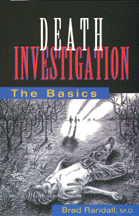|
 Death
Investigation: The Basics Death
Investigation: The Basics
Brad Randall, M.D.
1-883620-24-4
168 pages. Bibliography, index
Catalog # 016 $24.95 Softcover
©1997, Galen Press, Ltd., Tucson, AZ

A
body is found . . . Foul play is suspected . . .
What happens next?
Learn
the basics of death investigation from a pro:
-
When do coroners or medical examiners order autopsies?
- How
to track down vital evidence?
- How
to determine the range of fire of a shotgun?
- How
to conduct a scene investigation?
- What's
the difference between the cause and the manner of death?
- How
do investigators identify a decomposed body?
- What
parts of a death certificate need to be completed?
- How
do you establish a time of death?
This
basic death investigation handbook reveals what to do from the moment
a body is discovered, including how to identify basic gunshot wounds,
how to respond to hit-and-run death scenes, when to call a forensic
pathologist, and much more. Real-life scenarios illustrate the situations
death investigators encounter every day.
Death
Investigation: The Basics emphasizes the diverse roles of the many
professionals who make up a successful death investigation team,
including coroners and medical examiners, physicians, emergency
medical personnel, nurses, funeral directors, forensic technicians,
law enforcement, the news media, and legal experts.
Includes
numerous flow charts, tables, illustrations, and sample forms to
help new investigators begin their first day on the job. Difficult
questions are clarified, such as when professionals need to call
on death investigators and when and why autopsies are ordered. The
book also provides up-to-date information on Sudden Infant Death
Syndrome and a detailed description of how to proceed with an infant
death investigation.
About the author:
BRAD
RANDALL, M.D., is a nationally recognized forensic pathologist,
has served as Medical Examiner for most of the eastern half of South
Dakota, southwest Minnesota, northwest Iowa, and northeastern Nebraska
during the last fifteen years. He is widely published and teaches
at the University of Iowa College of Medicine. After frequent, panicked
calls from new death investigators, Dr. Randall decided to write
a guide for beginners to death investigation. His involvement in
the Aberdeen Area Indian Infant Mortality Study sparked his interest
in Sudden Infant Death Syndrome (SIDS).
Softcover,
192 pp.
# 016 $24.95
TABLE
OF CONTENTS
1: Death Investigators
2:
Determining Which Deaths To Investigate Statutes; Community Service;
Jurisdiction; Notification.
3:
Scene Investigation Visiting Death Scenes; The Non-Homicide Scene;
The Homicide Scene; Mass Disaster Scenes (Multiple-Fatality Incidents);
The Displaced Scene; The Hospital Scene; Specialized Scenes; Entrance
and Exit Wounds.
4:
Body Identification Visual Identification; Identification at "Closed"
Scenes; Other Methods of Identification.
5:
Time of Death.
6.
Public Relations Notifying Families; The Media; Documentation.
7.
The Autopsy Forensic Pathologists; Families; Funeral Directors.
8.
The Death Certificate Cause of Death; Manner of Death.
9.
Sudden Infant Death Syndrome & Death Investigators Diagnosis
of SIDS; Dealing with The Family or Caregiver; Impact on Family
Members and Caregivers; Impact on Responders and Investigators;
Current Research.
Bibliography
Appendices:
Organizations; Death Investigation Form; Body Diagrams; MMWR Guidelines
For SIDS Death Scene Investigation
Index
List of Figures
Figure P.1: Aberdeen Service Area of the Indian Health Service.
Figure 1.1: The Death-Investigation Team
Figure 1.2: Public-Health Roles of Death Investigators
Figure 2.1: Typical Death-Investigation Statutes
Figure 2.2: "Lost Hope County" Jurisdiction
Figure 3.1: Flow Chart for Scene Management
Figure 3.2: Right-Angled "Dicing" Injuries
Figure 3.3: Powder Residue-Intermediate Range of Fire
Figure 3.4: Powder Residue-Close Range of Fire
Figure 3.5: Powder Residue-Direct Contact)
Figure 3.6: Stellate Laceration from a Gunshot
Figure 3.7: Explosive-Destructive Gunshot Wound
Figure 3.8: Shotgun Wound-Close Range
Figure 3.9: Shotgun Wound-Intermediate Range of Fire
Figure 3.10: Shotgun Shell
Figure 3.11: Muzzle Imprint of a Double-Barreled Shotgun
Figure 3.12: Gunshot Entrance Wound
Figure 3.13: Gunshot Exit Wound
Figure 3.14: Matching a Weapon to a Wound
Figure 3.15: Coin-Rubbing Injuries
Figure 3.16: Stab Wound
Figure 3.17: Decomposed Body
Figure 4.1: Flow Chart for Corpse Identification
Figure 7.1: Determining the Need for an Autopsy
Figure 8.2: Detail of the Standard U.S. Death Certificate
Figure 8.3: Cause-of-Death Statement
Figure 8.4: Inappropriate Terms for Cause-of-Death Statements.
Figure 8.5: Cause-of-Death Statements in Unnatural Deaths
Figure 9.1: Distribution of SIDS Deaths by Age
Figure 9.2: Distribution of U.S. SIDS Deaths by Month, 1992
Figure 9.3: Investigation of Infant Deaths
Figure 9.4: Information to Collect in SIDS Investigations
Figure 9.5: Typical Physical Appearance of an Infant who Died of
SIDS
Figure 9.6: Reactions of Parents and Caregivers after SIDS Deaths
©1997-2001,
Galen Press, Ltd., Tucson, AZ
Extras:
Death Investigation Factoids
DECOMPOSITION
Funeral Industry Jargon
ORGAN AND WHOLE-BODY DONATION CARDS
"The Worm Song"
A Sample Protocol to Use When Speaking
With Survivors
Expected
versus Sudden, Unexpected Deaths (Table 1-1)
|
